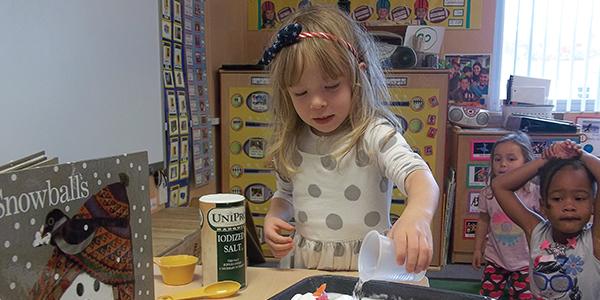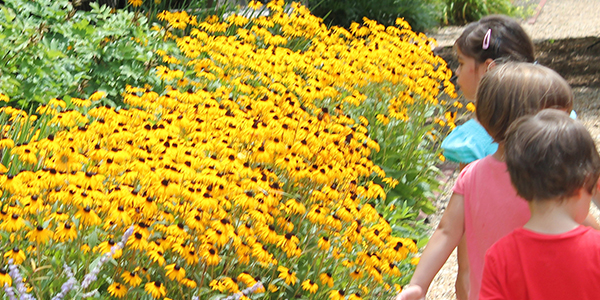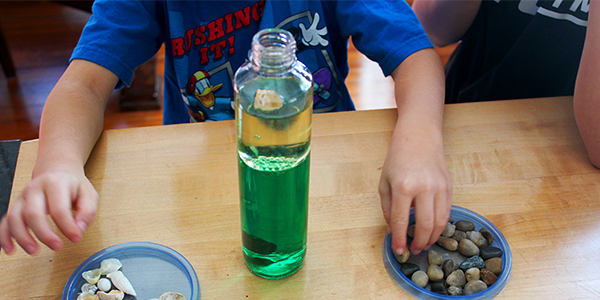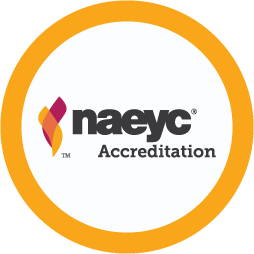Breaking Down STEAM for Young Children

You are here
This is the first article in a four-part series. Here, we introduce three examples of STEAM instruction in early childhood settings. (STEAM refers to science, technology, engineering, art, and mathematics.) In the rest of the series—which will be published in future issues of TYC—we take a deeper look at each of these examples, focusing on extending children’s STEAM learning through conversations, open-ended questions, and informal assessments.
STEAM for young children falls under the umbrella of inquiry instruction. Inquiry instruction encourages active (often hands-on) experiences that support building understanding and vocabulary, critical thinking, problem solving, communication, and reflection. You can facilitate inquiry experiences by creating opportunities for children to learn about the world through STEAM lenses and by asking high-quality, open-ended questions. Inquiry practices provide young children with opportunities to approach problems in new and authentic ways.
In early childhood, we encourage STEAM teaching to integrate these subject areas within a meaningful context. STEAM integration helps teachers focus on content (what to learn) and processes (how to learn). For example, you could engage children in recording the weather each day on a chart and creating weekly summaries (three sunny days, two cloudy days) to support their learning of science and math content and also data gathering and analysis processes.
For a long-term, well-integrated STEAM project, you could support children as they learn about what conditions are best for a class pet and then explore locations (a dark corner or a sunny window?), observe conditions (too cold or too hot?), measure spaces (is the table big enough for a cage, an observation space, and a caretaker schedule?), and draw plans to create the pet’s new classroom home.
As you dive into integrated activities, you’ll see that the STEAM fields provide complementary perspectives on the world. They also promote similar processes for learning, such as asking questions, making connections with prior knowledge, gathering and analyzing data (including observations), and communicating findings and ideas.
Example 1: STEAMing with projects
 One method for integrating STEAM in your classroom is through child-centered projects. For example, Ms. White’s year-round class of 4- and 5-year-olds was particularly interested in learning about seeds and plant growth. To support the children’s interests, Ms. White proposed that the class plan, design, plant, and take care of a class garden. Over the course of several weeks, the children researched plants and worked together to choose what to plant in their garden.
One method for integrating STEAM in your classroom is through child-centered projects. For example, Ms. White’s year-round class of 4- and 5-year-olds was particularly interested in learning about seeds and plant growth. To support the children’s interests, Ms. White proposed that the class plan, design, plant, and take care of a class garden. Over the course of several weeks, the children researched plants and worked together to choose what to plant in their garden.
Once they finalized their planning, they planted seeds and cared for them in the classroom until the plants were mature enough to be planted outdoors. Then, Ms. White and two parent volunteers created a raised flower bed on the playground so the children could regularly observe and care for the plants.
Over the course of the summer and into the fall, the children cared for their plants; measured and recorded the plants’ growth; and shared their crops of herbs, vegetables, and flowers with others in the school. The children’s experiences in this project integrated visual arts; science content; and the STEAM processes of problem exploration, design, planning, measuring, and recording observations.
Example 2: STEAMing with problems
 To infuse STEAM throughout the day, consider making use of the common problems in your classroom. Problems like how children might share a snack, how to organize materials in the house area, or how to reuse materials in the classroom for an art project can be used to create a STEAM experience.
To infuse STEAM throughout the day, consider making use of the common problems in your classroom. Problems like how children might share a snack, how to organize materials in the house area, or how to reuse materials in the classroom for an art project can be used to create a STEAM experience.
An example of this problem-based approach took place in Mr. Barron’s preschool classroom. The children were struggling with the problem that outdoor playtime wasn’t fair because some children did not have opportunities to use the swings. Mr. Barron encouraged the children to explore various solutions to this problem, such as timed turns, weekly schedules, or even developing a point system to determine how long and how often each child could use the swings.
For each of these solutions, the children discussed the positives and negatives and then decided as a group on the strategy that would work best for the whole class. This was a STEAM experience because children had to use reasoning to decide on solutions and reflect on those solutions to settle on an overall strategy for the use of the swings. They also had to represent their solutions through drawings or charts and collect data every day on their opinions for each solution (taking turns, a weekly schedule, or a point system).
Example 3: STEAMing with play
 While the first two examples focus on STEAM in projects and problems, this third example shows the STEAM experiences that can emerge from play. In Mrs. Schmidt’s class, Luca, a 4-year-old, had been exploring different materials in the science center. Mrs. Schmidt had set out a variety of materials and a water and sand table for exploration. The children naturally became intrigued with exploring how the different materials responded to being placed in the water—some items sank quickly, some floated, and some appeared to float for a brief time before slowly sinking. The children even collaborated with the teacher to create a chart to note which materials floated and which sank.
While the first two examples focus on STEAM in projects and problems, this third example shows the STEAM experiences that can emerge from play. In Mrs. Schmidt’s class, Luca, a 4-year-old, had been exploring different materials in the science center. Mrs. Schmidt had set out a variety of materials and a water and sand table for exploration. The children naturally became intrigued with exploring how the different materials responded to being placed in the water—some items sank quickly, some floated, and some appeared to float for a brief time before slowly sinking. The children even collaborated with the teacher to create a chart to note which materials floated and which sank.
After the creation of the chart, Luca asked Mrs. Schmidt if he could create his own discovery bottles. He was interested in making a sink bottle and a float bottle. He noticed that other discovery bottles in the classroom had different colors of water and some had oil that separated from the water. With Mrs. Schmidt’s assistance, Luca explored the effects of adding oil to the sink or float experiment by using seashells and rocks he had specifically chosen to test.
In this example, Mrs. Schmidt supported STEAM learning through the materials she placed in the science center to inspire playful learning. This type of experience will often take off in new directions as children build their understandings and extend the experience, as Luca did.
Luca’s experience in this playful exploration of materials integrated science and mathematics content and the STEAM processes of problem exploration, recording observations, and experimentation.
In closing
STEAM activities can take many forms, all of which are beneficial for young children. Think about which of these approaches might work best in your own classroom setting. You can even do more than one of them at a time!
Regardless of which strategy you use for implementing STEAM, remember that it takes time for children to become problem solvers. In part two of this series, we will take a deeper look at the communication in Ms. White’s, Mr. Barron’s, and Mrs. Schmidt’s classrooms during these STEAM examples to show how you can support children’s learning through conversation. In the meantime, keep providing opportunities for children to explore, and you will begin to see how fun STEAM can be! Read part 2 of Breaking Down STEAM.

STANDARDS 2: CURRICULUM; 3: TEACHING
2G: Science
3E: Responding to Children’s Interests and Needs
3G: Using Instruction to Deepen Children’s Understanding and Build Their Skills and Knowledge
Photographs: © Lakshini Wijeweera (top); © Getty Images (girl on swing); courtesy of the authors (wildflowers, bottom)
Sandra M. Linder, PhD, is an associate professor of early childhood mathematics education at Clemson University. Her research focuses on supporting home mathematics and STEAM environments.
Angela Eckhoff, PhD, is an associate professor of teaching and learning–early childhood at Old Dominion University, in Norfolk, Virginia.